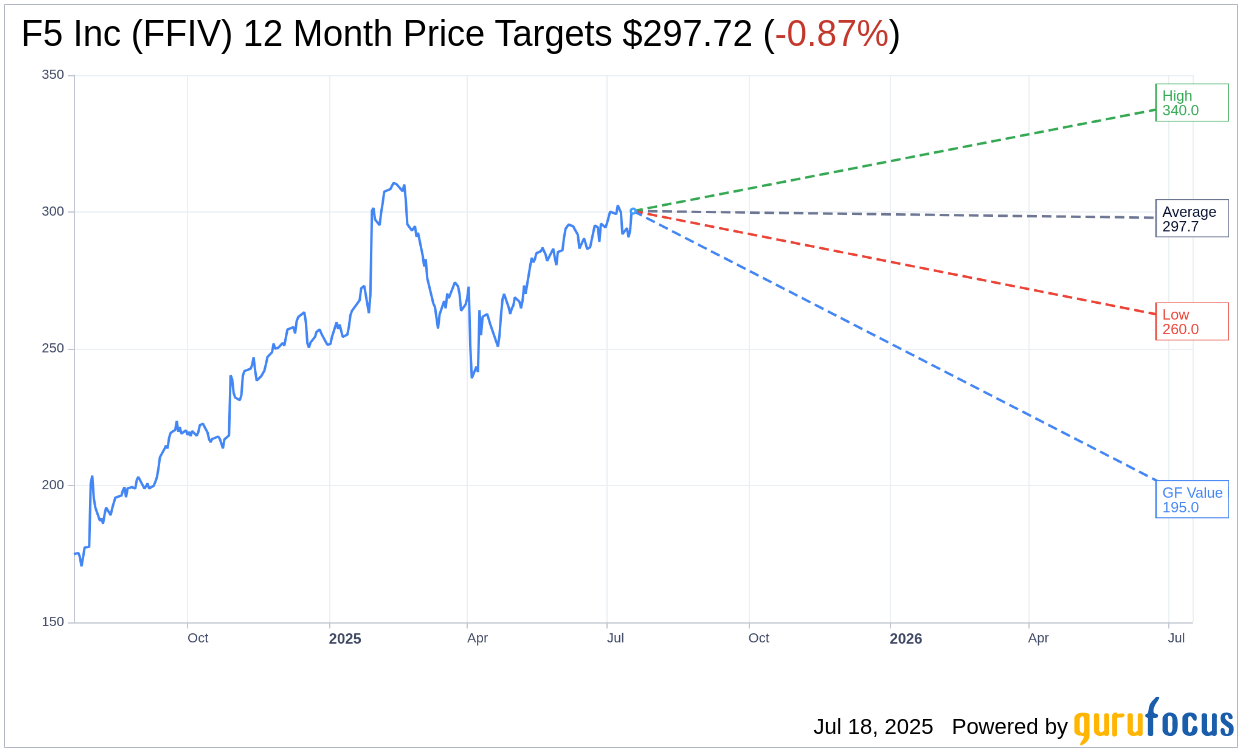Morgan Stanley has adjusted its price target for F5 Networks (FFIV, Financial), raising it to $305 from the previous $280 while maintaining an Equal Weight rating on the stock. This decision follows the firm's recent quarterly call with Enterprise value-added resellers, where second-quarter performance was reported to be in line with or slightly above expectations.
Notably, there has been a "clear improvement" in spending patterns during May and June compared to April, with checks on F5 Networks showing unexpectedly positive results. This suggests a more favorable outlook for the company moving forward.
Wall Street Analysts Forecast

Based on the one-year price targets offered by 10 analysts, the average target price for F5 Inc (FFIV, Financial) is $297.72 with a high estimate of $340.00 and a low estimate of $260.00. The average target implies an downside of 0.87% from the current price of $300.34. More detailed estimate data can be found on the F5 Inc (FFIV) Forecast page.
Based on the consensus recommendation from 14 brokerage firms, F5 Inc's (FFIV, Financial) average brokerage recommendation is currently 2.9, indicating "Hold" status. The rating scale ranges from 1 to 5, where 1 signifies Strong Buy, and 5 denotes Sell.
Based on GuruFocus estimates, the estimated GF Value for F5 Inc (FFIV, Financial) in one year is $195.04, suggesting a downside of 35.06% from the current price of $300.34. GF Value is GuruFocus' estimate of the fair value that the stock should be traded at. It is calculated based on the historical multiples the stock has traded at previously, as well as past business growth and the future estimates of the business' performance. More detailed data can be found on the F5 Inc (FFIV) Summary page.
FFIV Key Business Developments
Release Date: April 28, 2025
- Total Revenue Growth: 7% increase year-over-year.
- Product Revenue Growth: 12% increase year-over-year.
- Systems Revenue Growth: 27% increase year-over-year.
- Software Revenue: Flat compared to the year-ago quarter.
- Non-GAAP EPS: $3.42, representing 18% year-over-year growth.
- Global Services Revenue: $394 million, 3% growth year-over-year.
- Recurring Revenue: 72% of total Q2 revenue.
- Non-GAAP Gross Margin: 83.1%, up 98 basis points year-over-year.
- Non-GAAP Operating Margin: 31.9%, an improvement of 103 basis points year-over-year.
- Cash Flow from Operations: $257 million, a record for the company.
- Deferred Revenue: $1.92 billion, up 6% from the year-ago period.
- Stock Repurchase: $125 million worth of shares repurchased in Q2.
- Q3 Revenue Outlook: Expected range of $740 million to $760 million, implying 8% growth at the midpoint.
- FY25 Revenue Growth Outlook: Raised to 6.5% to 7.5% from prior 6% to 7%.
- FY25 EPS Growth Outlook: Raised to 8% to 10% from prior 6.5% to 8.5%.
For the complete transcript of the earnings call, please refer to the full earnings call transcript.
Positive Points
- F5 Inc (FFIV, Financial) reported a 7% total revenue growth in Q2, with product revenue growing by 12% and systems revenue by 27%.
- The company delivered a Q2 non-GAAP EPS of $3.42, representing an 18% year-over-year growth, exceeding the top end of their guidance range.
- F5 Inc (FFIV) raised its FY25 revenue growth guidance to a range of 6.5% to 7.5%, up from the prior range of 6% to 7%.
- The introduction of the F5 application delivery and security platform (ADSP) is a significant innovation, converging high-performance load balancing and traffic management with advanced app and API security capabilities.
- F5 Inc (FFIV) is seeing strong early interest in its AI gateway solution, which is designed to secure and manage enterprise AI, indicating potential future growth in AI-related revenues.
Negative Points
- Software revenue was flat compared to the year-ago quarter, with subscription-based software revenue down 2% year-over-year.
- The company faces macroeconomic uncertainties, which could impact future demand and growth projections.
- Despite strong hardware growth, there is a concern about potential deceleration in the second half of the year due to conservative guidance amidst macro volatility.
- The renewal cycle for software subscriptions is heavily weighted towards the second half of the fiscal year, which could lead to uneven revenue recognition.
- There is a potential risk of disruption in the U.S. federal government sector due to budget uncertainties, which could affect future revenues.
